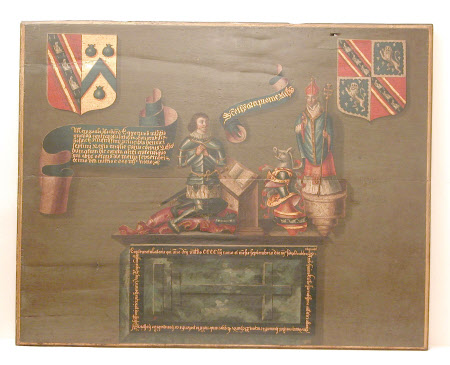The Tomb of Sir Richard Edgcumbe (d.1489) at Morlaix
British (English) School
Category
Art / Oil paintings
Date
1700 - 1799
Materials
Oil on panel
Measurements
610 x 762 mm (24 x 30 in)
Place of origin
England
Order this imageCollection
Cotehele, Cornwall
NT 348080.1
Summary
Oil painting on oak panel, The Tomb of Sir Richard Edgcumbe (d. 1489) at Morlaix, British (English) School, 18th century.Two figures are seen on a tomb, flanked by two coats-of-arms. Sir Richard Edgcumbe, as a knight, is kneeling on the tomb on the left, at a prieu-dieu before a statue of a bishop and a boar figurine. The tomb is decorated with a horizontal cross, surrounded by an inscription (1). To the knight's right is a scroll with a detailed inscription (2), above which is one of the coats-of-arms and to his right another scroll, as if coming for his mouth, with a single lined inscription (3). The painting is probably based on COT.D.2 (NT 347613).The tomb, which was destroyed in the Revolution, was at Morlaix in Brittany, where Sir Richard Edgcumbe died in 1489. Inscription (1) reads "Before the central high altar of this church there is buried the body of Richard Edgcumbe, mighty knight and keeper of the records of the Hospital of the most excellent Prince Henry VII of England, who full of faith in the year 1489 and on the 4th day of September was buried from the light". Inscription (2) reads "To the memory of Richard Edgcumbe, Knight, most honourable keeper of the Records of the most excellent hospital of Prince Henry the seventh of England, whose body remains here buried by the high altar, who died on the 8th day of September 1489". (Note conflict of date). Inscription (3) reads "Saint Thomas pray for me, Richard."
Provenance
Thought to have been commissioned by George Edgcumbe, 3rd Baron (1720-1795), to furnish the Chapel in the Wood which he restored in 1769; left at the property when Cotehele was accepted in lieu of tax from Kenelm, 6th Earl of Mount Edgcumbe (1873–1965) and transferred to the National Trust in 1947; and amongst the contents accepted in lieu of estate duty by HM Treasury and transferred to the National Trust in 1974
Credit line
Cotehele, The Edgcumbe Collection (National Trust)
Marks and inscriptions
Recto: Inscription around painted tomb: "Before the central high altar of this church there is buried the body of Richard Edgcumbe, mighty knight and keeper of the records of the Hospital of the most excellent Prince Henry VII of England, who full of faith in the year 1489 and on the 4th day of September was buried from the light". Recto: On scroll on left: "To the memory of Richard Edgcumbe, Knight, most honourable keeper of the Records of the most excellent hospital of Prince Henry the seventh of England, whose body remains here buried by the high altar, who died on the 8th day of September 1489". [sic;note conflict of date] Recto: On scroll in centre in single line: "Saint Thomas pray for me, Richard."
Makers and roles
British (English) School, artist

